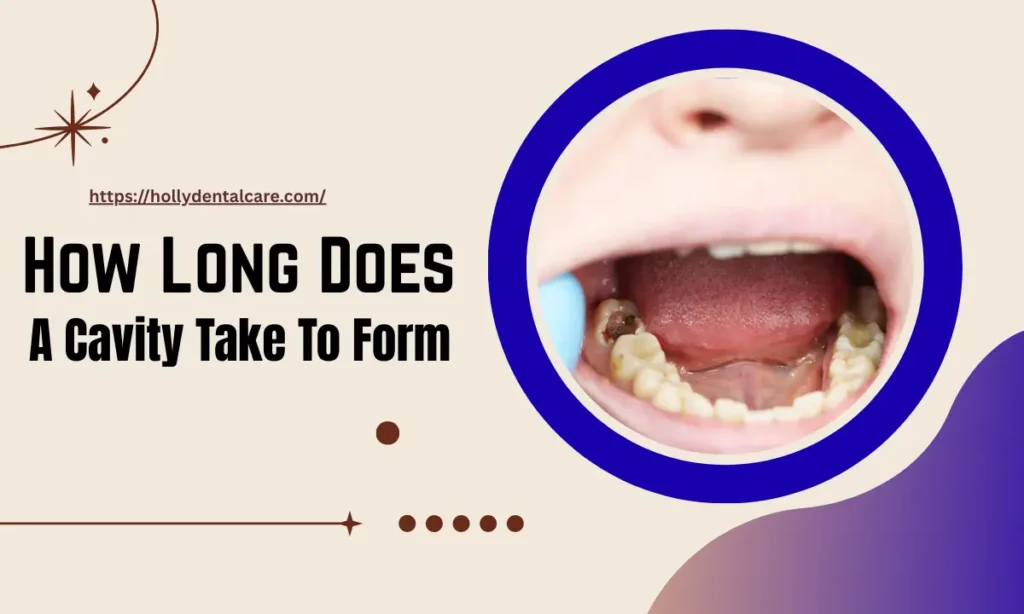Dental caries are among the most common health issues that occur worldwide. Though numerous developments have made teeth cleaning more effective, it is estimated that the number of people with untreated tooth decay in their permanent teeth is over two billion, and caries in the milk teeth of children affect more than 500 million kids. Among the top queries that the dental practitioners get asked is “How Long Does a Cavity Take to Form“. Their response, however, is not just a single number of days. The decay continues to grow through an interactive process which is your diet, saliva, hygiene, and even genetics. Understanding the decay timeline can help you to recognize the issue early and maintain your beautiful smile forever.
What Exactly Is a Cavity?
A cavity is a hole or space in a tooth that has been made by acid damage. The bacteria that live in plaque consume sugars and give off acids that wear down the enamel. Decay starts when the process of demineralization outweighs the natural repair with the help of saliva and fluoride. The decay continues to the next stage which is the breakdown of enamel. Bacteria are now able to go deeper into the dentin and reach the pulp. Besides decay, bacteria can cause infection in the pulp, leading to toothache. Only the first stage is reversible, once a hole forms, treatment by a dentist is necessary.
Tooth Decay Stages & Timeline
Plaque Accumulation (Hours to Days)
Just minutes after brushing plaque starts forming and it consolidates within 24–72 hours, thus becoming a highly acidic environment.
Initial Demineralization (Weeks to Months)
The acids are gradually taking away the minerals from the enamel and at times white spots appear; however, proper hygiene and fluoride can halt or even go back to this phase.
Enamel Breakdown (3–12 Months)
The situation is acid continues to attack, the enamel becomes weaker, and a small hole in the enamel can be visible within several months to a year.
Dentin Decay (Months)
Decay moves quickly in the softer dentin, meaning that it is likely to spread rapidly without giving the opportunity of discomfort to occur.
Pulp Involvement (Months to Years)
The condition extends to the pulp causing its swelling and the person will feel pain or there will be an abscess if the decay is still allowed to continue, thus, the range of the progress will be from months to years.
Factors That Influence How Fast Cavities Form?
- Saliva Flow & pH: Saliva neutralizes acids and provides the enamel; dry mouth caused by medications, lack of water, or an illness.
- Fluoride Exposure: Fluoride revitalizes enamel and keeps the remineralization process going; no fluoride means a very high rate of the occurrence of cavities.
- Tooth Anatomy: The molars with their deep fissures and the crowded teeth are those places where food gets trapped and cleaning is hard.
- Age: The enamel of kids is thin and hence decay happens at a faster rate, on the other hand, elderly people may get root caries as a result of gum recession.
- Medical Conditions: Diseases like diabetes, eating disorders, or acid reflux can cause the weakening of the enamel or alter the saliva chemistry which, in turn, increases the cavity risk.
Early Signs That a Cavity Is Developing
- Dental decay is usually started with enamel that changes color gradually that can be white or brown spots.
- Teeth sensitivity to sweets, cold, and hot foods is also an early sign of a cavity.
- Feeling of roughness when you run your tongue over teeth is a symptom of a cavity.
- The presence of persistent bad breath or unpleasant taste in the mouth is one of the early signs of a cavity.
Methods of Preventing the Cavity
- Fluoride toothpaste brushing should be done twice a day for two minutes. Flossing once a day is advised.
- Do not consume more than a limited amount of sugary and acidic foods and drinks. Water is the best. Rinse or brush after 30 minutes.
- If you are the one who is most cavity-prone, use a fluoride rinse or get dental sealants.
- Decay of the teeth can be avoided by drinking a lot of water, chewing sugar-free gum, and treating dry mouth.
- Have dental check-ups and get cleanings at the dentist’s office every six months, and get X-rays if needed.
Special Considerations for Children
Baby teeth (primary teeth) are made of enamel and dentin which are thinner, therefore the decay can extend two to three times faster than in adult teeth. The decay of a child’s primary teeth can also cause damage to the permanent teeth below as well as cause speech and nutrition disorders.
Parents have to:
- From the moment the first tooth comes through the gum, start the brushing.
- Never give a bottle of milk or juice to a baby to be put to sleep.
- Arrange the first dental appointment before the child turns one year old.
When to See a Dentist
- Extreme tooth sensitivity or pain that won’t go away
- Finding small holes in teeth or bright spots
- Gum swelling or any pus coming out near a tooth
- The area where the food keeps getting stuck
Conclusion
It is not a cavity that comes overnight. The journey with the loss of minerals which are microscopic and may take several months or even years to become a hole that is visible but the change to the damaged part of the tooth enamel is quite fast. The most effective offense is the habit: brushing, flossing, controlling your diet, and visiting your dentist regularly. Tooth decay is one of the few chronic diseases that are almost completely preventable. If you acknowledge the time they take to develop, you will be able to identify the risk factors sooner, halt the disease’s advance, and keep your teeth strong and healthy for your entire life.
Also read:- Home Dental Hygiene Remedies: Natural Ways to Keep Your Teeth and Gums Healthy



